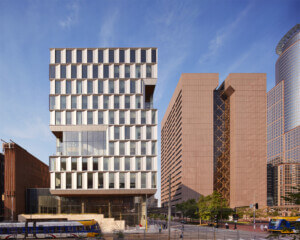It may be no coincidence that the Walker Art Center, in conjunction with the unveiling of its new streamlined main entrance and lobby, has also opened a new exhibition of highly conceptual, intellectually exhilarating work that is oftentimes, concurrently, as bewildering as the welcoming new foyer is transparent. Question the Wall Itself—from its title to the show’s most architectural work—graciously invites interrogation.
They are installations in which traditional ideas of space, interiors, exterior structure, and the decorative are literally turned inside out, upside down, and sliced open, reassembled, or punctured. None accomplishes this more pointedly, perhaps, than Jonathan de Andrade’s Nostalgia, sentimiento de classe (Nostalgia, a class sentiment).
Andrade’s installation gets its own room, on which the white walls are printed with texts on “tropical modernism” by mid-20th-century Brazilian architecture writers Marcos Vasconcellos and Flavio de Carvalho, but with significant words replaced with red, blue, black, and yellow fiberglass shapes (blocks, triangles, rectangles). Resting on the floor is a framed photo of a 1960s entryway, which inspired the shapes, from a house in the artist’s home city of Recife. (Note the parrot in the photograph; more on that soon).
The overall effect of Andrade’s work is Mondrian-like, conjuring fantasies of a Lego party attended by mid-century design thinkers. But the installation—with its layering of references to the public and private, political and cultural, material and verbal—also points to how the exhibition as a whole examines, through a wide range of cultural frames, how interior spaces reflect ideas of identity.
Curated by Fionn Meade, the Walker Art Center artistic director, the show includes—in addition to installations—sculpture, video, photography, and other multimedia works by 23 artists from around the globe. Reflection, not coincidentally, is a recurring theme throughout the exhibition, as mirrors abound. So do parrots.
The birds, signifiers of repetition and mimicry, first appear in Marcel Broodthaers’ Dites partout que je l’ai dit (Say Everywhere I Said So), an installation that encompasses a drawing of a parrot from a bird species index, a taxidermied parrot inside a bell jar, a box splashed with paint and a taped recording of Broodthaer repeating lines from his poetry.
Broodthaer’s concept of “esprit décor” guided the exhibition’s curation, Meade explained. He described it as a critique of ideas about internationalism, national identity, globalization, and institutional space—all through the lens of how interior space is constructed. The most shocking manifestation of which is Rosemarie Trockel’s As far as possible.
Occupying its own room—its antiseptic white-tiled walls conjure chilling sensations of a hospital cleanroom or testing laboratory—Trockel’s installation includes taxidermied, mechanized songbirds and a bell under a bell jar (representation and mimesis, anyone?) in a white metal cage, an upside-down palm tree, a sculptural mass that might be a urinal and a print of Gustave Courbet’s L’Origine du monde over which the artist strategically placed an image of a tarantula.
Forget “Bathroom of the Day” on Houzz; Trockel’s installation is straight out of an indie science-fiction/horror film, while its props and decor—worthy of a stage or set design—summon Freud’s psychological concept of “the uncanny.” Theaster Gates’s A Maimed King also uses an array of objects, but to summon emotional resonance with political and cultural consequences.
His installation has an office chair facing a battered aluminum bulletin board framing a crumpled, torn image of Dr. Martin Luther King Jr. (salvaged from a condemned school in Chicago). On either side are blackboard-like sculptures, one called House Nation Wall and the other Founder’s Plaque, which suggest a rebuilding of a musical, educational, and cultural world that values inclusivity; institutions that still need to be built.
Similarly, such structures have yet to be constructed in the Arab world, argues Walid Raad in his 11-panel installation Letters to the Reader. Placed like dominoes in a graceful arc, each eight-by-four-foot painted panel features a thin cutout (some of which resemble fragments of an ornate picture frame) above a trompe l’oeil parquet or wood floor. Each panel also represents a fragment of a wall from a fictitious art gallery in Saudi Arabia and the United Arab Emirates, calling into question issues of the place and prospect of Arab art in traditional Western contexts.
Lucy McKenzie’s Loos House is also a shadow structure of sorts. McKenzie’s installation deploys trompe l’oeil painting techniques to render her brusque not-to-scale layout of the Austrian architect’s 1930 Villa Müller (hers is an unfaithful copy, full of voids) in the cipollino green marble of the home’s salon, inverting the interior and exterior, public and private spaces. In her accompanying work, Fascist Bathroom, McKenzie similarly transposes the most private and intimate by enclosing oil-on-paper paintings of an opulent lavatory in a white-walled box.
Tom Burr’s Zog (a series of setbacks) brings the interrogation home, quite literally, with a sculpture that questions the corner offices of the IDS Center in downtown Minneapolis, a landmark skyscraper designed by Philip Johnson. One side of the work (the public side?) is comprised of 12 glass-fronted “zogs” that reflect the observer. On the inside are stainless-steel panels printed with Burr’s photos of Philip Johnson’s Glass House: imagistic fragments in which Burr is often reflected.
Repetition and reflection; homage and critique; mimicry and mimesis; staging and sets; fragments and shadows: Question the Wall Itself was curated over a period of several years, yet is strangely of its time. At a time when fascism, seemingly in the guise of nationalism, is rearing its hydra-head around the globe, and fears of exclusivity rise as elitism cloaks itself in populism, and lies are allowed to masquerade as truth, the fractured architectural narratives of the exhibition are poignantly resonant. Question everything, seems to be the message, not just the wall.
Question the Wall Itself
Walker Art Center
725 Vineland Place, Minneapolis
Through May 21, 2017










